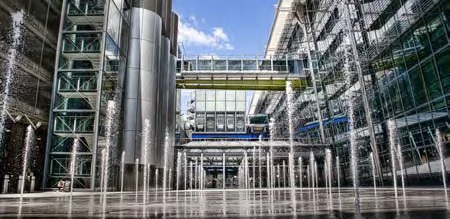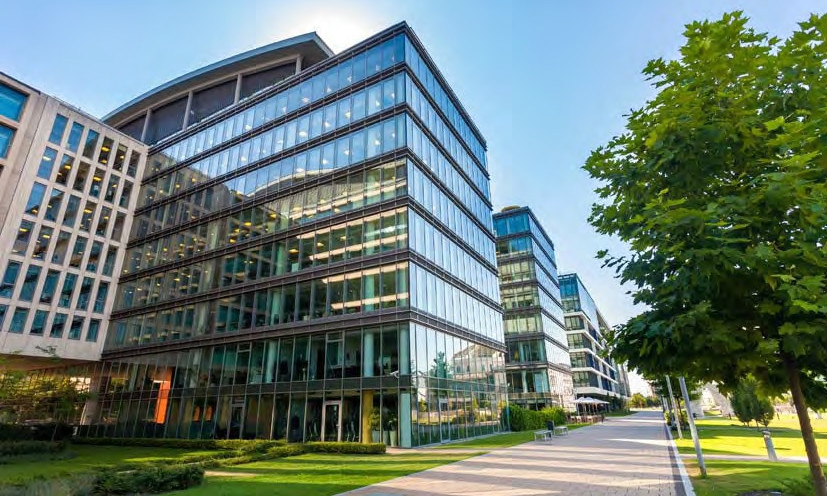'This article was first delivered in lecture form at the IFSEC Academy
Martin Grigg of the PTS Consulting Group illustrates how security systems in truly ‘intelligent’ buildings are empowering facility managers as data gathering evolves beyond mere aggregation of information. Discriminating use of big data is allowing building owners and tenants to make meaningful connections between atypical and potentially threatening situations however disparate the alert types might be. Grigg discusses how physical and IT security strategies in intelligent buildings are converging. He touches on Douglas Adams, Stephen Hawking and even the ‘butterfly effect’ in chaos theory along the way.
Few people in the physical or IT security sectors will dispute that ‘Big Data’ data is likely to make our working lives safer and protect our infrastructure but only if artificial intelligence is harnessed to filter and evaluate the information, finding structure and patterns that can either guide us towards best practice in building administration or expose potential and actual threats.
Facility managers who have spent much of their lives dealing with security systems that have seldom been more than separate, unconnected entities such as CCTV, access control, intruder detection and visitor management, are now enjoying the benefits of interconnectivity as the IP revolution assigns IP addresses to just about every device. Managers are beginning to inhabit a connected building zone of components and sensors, and if they are of a certain age they might liken their new situation to that of Dirk Gently, the ‘holistic detective’ created by Douglas Adams, who exploits ‘the fundamental interconnectedness of all things’ in order to arrive at stunning solutions of ‘whole crimes’ and uncover ‘whole criminals’. The new interconnectivity of formerly disparate security equipment is a close parallel to Adams’s crime novels.
But how does a facility manager progress from the Dirk Gently situation (it can just as easily be described as ‘the Internet of Everything’ – a phrase first coined by Cisco but now in common parlance) where the building is merely converged to a truly intelligent building? Convergence is easy; if an office meeting room is booked for a certain slot, the air-conditioning can be put on for that period. But we are no longer, say, making a hard-wired connection between requests to use a room and air-conditioning; the communication is between devices which are all identifiable on a network. Facility booking can be linked with visitor management systems, and the facilities can be as diverse as video/audio conferencing, broadcast equipment, digital signage and collaboration tools. The PTS Consulting Group is finding that audio/visual is an increasingly important component within the design of physical security and IT systems at major corporate clients.
Effective aggregation and rules engines
 Big Data flying around a building, a campus-style estate or even corporate offices in different countries is only of value if it is aggregated effectively and subjected to rules engines. A system that alerts on abnormal incidents (or more crucially a set of abnormal incidents) is offering true intelligence to the user. This may well bring back your school memories of the ‘logic’ gates of Boolean algebra but there is a higher level of intelligence, an ‘intelligent zone’ where trends are analysed, predictions are made, and decisions are both analysed and executed based on the bigger picture and the best information available.
Big Data flying around a building, a campus-style estate or even corporate offices in different countries is only of value if it is aggregated effectively and subjected to rules engines. A system that alerts on abnormal incidents (or more crucially a set of abnormal incidents) is offering true intelligence to the user. This may well bring back your school memories of the ‘logic’ gates of Boolean algebra but there is a higher level of intelligence, an ‘intelligent zone’ where trends are analysed, predictions are made, and decisions are both analysed and executed based on the bigger picture and the best information available.
Imagine a building where reports are being received of an invalid card being presented to a door or a door held. At a large and busy site, these are likely to be regarded as low-level alarms. But the integration of many disciplines within facilities management may also allow a report of, say, an air-conditioning leak at the same time and flag this up to the operators who are also viewing the access control violations. The filtering of disparate big data in this manner makes control and monitoring processes intuitive; it optimises situational awareness and allows security guards and facility managers to make rapid informed decisions based on an array of data.
Intelligent buildings stream data constantly even during normal problem-free operation for trend analysis (including energy efficiency) and development of preemptive security measures.
Bi-directional exchange of information
As storage costs decrease, many companies are streaming big data into their silos without necessarily analysing it, possibly because they have the foresight to appreciate that interrogating the data in the near future may produce business benefits. Analysis of latent big data will often not only protect against major security breaches but can also monitor staff behaviour and movements. A company with a frequently-used meeting room – even one containing valuable conferencing equipment – would be unlikely to set the room’s intruder alarms during working hours. But the bi-directional exchange of information between security and facility management devices in a truly intelligent building might easily flag up the anomalous situation of a room booking system reporting that an area should be empty but an intruder alarm is reporting movement.
Any experienced facility manager observing this would predict that in all likelihood, legitimate staff members are holding an impromptu meeting but security guards have useful information on which to carry out a spot-check for intruders. Similarly, the intelligent building is able not only to accelerate a combination of low-level events (such as a temperature change at the same time as a break-glass incident) into a full alert but also investigate the events by using the same system intelligence. CCTV cameras can be sent on tours that are relevant to the incident and first-responders will be able to study this footage if it can assist them.
The revolution here is that disparate, enterprise-wide systems are talking to each other and the convergence is not just between physical security and building management. IT security is now integrated such that an attempt to, say, plug a USB drive into the network or some other aberrant network event at a physical location where there is unexpected sensor activity would trigger a high-level alert.
Interrogating and applying structure to big data in the intelligent building can have dramatic effects on general operational efficiency and carbon footprint. The PTS Consulting Group frequently works with clients who are occupying multi-tenanted buildings. Analysis of room sensor and access control reports may prompt a facility manager to ask: “Why are we heating this room and using air-conditioning in that area? Could it be better used as an occasional break-out meeting room? Do we even need to be paying our landlord £60 per square metre for it?
Big data is still underused by corporates
 Stephen Hawking once said: “Intelligence is the ability to adapt to change” and if here were observing the intelligent building sector rather than galaxies, he would be likely to tip organisations who are adapting to reap the benefits of interconnected devices as the ones who will prosper. And yet US-based technology analysts Gartner have predicted that despite the media hype over big data, by 2015 only 15% of Fortune 500 companies will be gaining competitive advantage through effective analysis of the data produced by the plethora of connected security and logistic devices discussed above.
Stephen Hawking once said: “Intelligence is the ability to adapt to change” and if here were observing the intelligent building sector rather than galaxies, he would be likely to tip organisations who are adapting to reap the benefits of interconnected devices as the ones who will prosper. And yet US-based technology analysts Gartner have predicted that despite the media hype over big data, by 2015 only 15% of Fortune 500 companies will be gaining competitive advantage through effective analysis of the data produced by the plethora of connected security and logistic devices discussed above.
It is the forward-thinking physical security and IT consultants who are using 3D data mining to apply structure to and then interrogate an array of data sources in order to first identify trends and then promote workplace innovation. They are not viewing big data as a cost and a drain on their storage capacities but as game-changing information source.
Scene analysis for logistics
One aspect of big data that offers both security and logistical benefits is the increasingly high quality video streams produced by IP cameras. These streams have prompted increased use of video analytics or ‘intelligent scene analysis’ whereby behavioural algorithms monitor an internal or external building scene over a long period to establish what content and activity is normal and then send an alert to an operator when something atypical occurs.
Additionally, analytics is being used not as a security measure or even to monitor staff compliance with corporate guidelines but rather to identify choke points, optimise the staggering of breaks, rationalise hot-desking policy, identify under-used areas, evaluate turnstile usage and even analyse use of lifts. Analytics can even be used to choose optimum days for client visits. (Should the office be near-empty, comfortably busy or crowded?) Human resources can specify behavioural detection that will tell them how many receptionists are needed at what times of the day, even to the point of interrogating data to see when the majority of contractors attend. Trend analysis derived from big data can optimise decision-making throughout an organisation, making it more agile and responsive to changing conditions.
In so far as rigorous scrutiny of one small aspect of employee behaviour extracted from big data, say, movement through turnstiles or speed gates at peak times, may prompt senior executives to make wide-ranging decisions on shift patterns, home working and hot-desking, this kind of analysis can be likened to Edward Lorenz’s view of chaos theory in which a minor event such as a butterfly flapping its wings may determine the course and intensity of a hurricane. From Dirk Gently to chaos theory is in fact a very small conceptual shift; further evidence if it were needed that big data is bigger than any of us has envisaged, all-pervasive and worthy of our close attention.
Martin Grigg is a principal consultant at PTS Consulting Group whose physical security division offers services including threat & vulnerability assessments, security master planning and physical security consulting. The division works with PSIM, CCTV, PIDS, intruder detection, access control and wide-area surveillance.
PTS Consulting Group is an independent management and information technology company employing over 400 delivery specialists from 18 offices in ten countries. The Group has over 3,500 clients and has delivered 10,000 projects.
For further information please visit www.ptsconsulting.com



